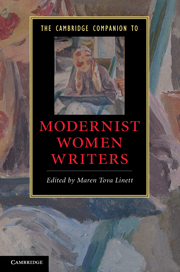Book contents
- Frontmatter
- Modernist women’s literature: an introduction
- 1 Transforming the novel
- 2 Modernist women poets and the problem of form
- 3 Women’s modernism and performance
- 4 Magazines, presses, and salons in women’s modernism
- 5 Gender in women’s modernism
- 6 Black women’s modernist literature
- 7 Race and ethnicity in white women’s modernist literature
- 8 Geomodernism, postcoloniality, and women’s writing
- 9 Women modernists and visual culture
- 10 Modernism and trauma
- 11 Political activism and women’s modernism
- 12 Religion and the occult in women’s modernism
- Guide to further reading
- Index
Modernist women’s literature: an introduction
Published online by Cambridge University Press: 28 November 2010
- Frontmatter
- Modernist women’s literature: an introduction
- 1 Transforming the novel
- 2 Modernist women poets and the problem of form
- 3 Women’s modernism and performance
- 4 Magazines, presses, and salons in women’s modernism
- 5 Gender in women’s modernism
- 6 Black women’s modernist literature
- 7 Race and ethnicity in white women’s modernist literature
- 8 Geomodernism, postcoloniality, and women’s writing
- 9 Women modernists and visual culture
- 10 Modernism and trauma
- 11 Political activism and women’s modernism
- 12 Religion and the occult in women’s modernism
- Guide to further reading
- Index
Summary
“New fields are opening and new laborers are working in them,” proclaimed Charlotte Perkins Gilman in 1911. In the early years of the twentieth century, practitioners of the arts saw a world of expanding possibilities. Gilman's metaphor, simultaneously nostalgic for rural authenticity and energized by modern productivity, captures a moment of self-conscious transition during which writers and artists sought to break with tradition and open “new fields” of artistic endeavor. Indeed Gilman (1860-1935) and her younger British contemporary Virginia Woolf (1882-1941) each wrote about the new ways fiction could represent life. Gilman wrote that “[t]he art of fiction is being re-born in these days. Life is discovered to be longer, wider, deeper, richer, than these monotonous players of one tune would have us believe.” Woolf said much the same thing, if in more poetic language, when she wrote that “[l]ife is not a series of gig-lamps symmetrically arranged; life is a luminous halo, a semi-transparent envelope surrounding us from the beginning of consciousness to the end . . . We are not pleading merely for courage and sincerity; we are suggesting that the proper stuff of fiction is a little other than custom would have us believe it.”
- Type
- Chapter
- Information
- The Cambridge Companion to Modernist Women Writers , pp. 1 - 16Publisher: Cambridge University PressPrint publication year: 2010



